Below is a detailed summary of David’s previous layout which has now been dismantled.
The build of his new layout starts here: Go to New Layout
Hornby-Dublo ‘Neverwazzass’
Presented by; David
Introduction.
‘Neverwazzass’ is a strange term and even stranger concept as it refers to models that were never actually made by Hornby-Dublo, hence the term ‘Never – was’. The whole ethos is that H-D ‘could’ have made these models and this display is representative of those that were actually planned for production and those that most H-D collectors & operators would have loved to have seen produced. On the basic level there are simple re-paints or cosmetic overlays of original H-D locomotives & rolling stock, liveries that H-D could have easily produced themselves with very little effort. On the second level there are ‘modifications’ made to existing loco’s, ranging from simple detail additions to major reconstructions but still using existing body shells, with a bit of effort H-D could have produced these as well as their ‘standard’ range. On the third level there are new body shells sat on heavily modified chassis, whole new locos (and some rolling stock), effectively brand new models produced in very small numbers and aimed primarily at the collector, but in them the spirit of Hornby-Dublo lives on.
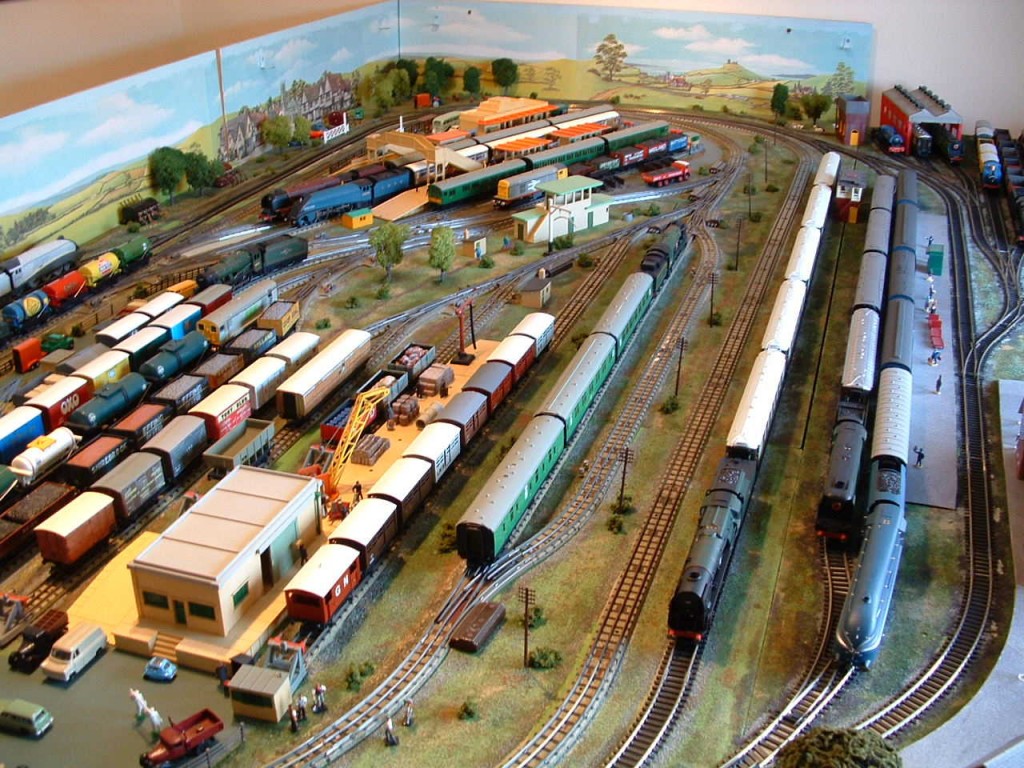 The models on display are a mixture of all three levels of the above, starting with re-paints of original models, some with minor modifications (try & spot the very subtle changes!) through major re-builds all the way to ‘brand new’ loco’s (including a few Wrenn models). However it is the ‘new’ loco’s that are perhaps the most interesting and these are described in more detail in the following pages. Even with new body shells and heavily modified chassis it should be remembered that all the motors and mechanism’s are at least 20 years old (Wrenn) and the majority date back to the 1950’s and early 1960’s and are a testimony to the durability & reliability of H-D models.
The models on display are a mixture of all three levels of the above, starting with re-paints of original models, some with minor modifications (try & spot the very subtle changes!) through major re-builds all the way to ‘brand new’ loco’s (including a few Wrenn models). However it is the ‘new’ loco’s that are perhaps the most interesting and these are described in more detail in the following pages. Even with new body shells and heavily modified chassis it should be remembered that all the motors and mechanism’s are at least 20 years old (Wrenn) and the majority date back to the 1950’s and early 1960’s and are a testimony to the durability & reliability of H-D models.
The main layout is mounted on a 9′ x 4′ (3 No. 3′ x 4′) boards and follows traditional lines in that it is a simple oval with two running tracks. Where space permits a further 2′ wide section can be inserted to increase the length of the layout, this is especially useful as it also increases the length of the freight sidings and allows longer trains to be displayed and run. The structures are mainly original
H-D with a few Tri-ang from the 1960’s added to give a bit of variety. The H-D buildings are a mixture of plastic and Aluminium (which are virtually indestructible) and all date from the late 1950’s/early 1960’s.
The Terminal station area to the far left of the layout was built as an extension to the main layout and occupies either a further 3′ x 4′ board or a 4′ x 6′ board (depending upon the available space), two slightly different extensions have been built to give the overall layout a high degree of flexibility. The main station/Terminal building is actually a Tri-ang/Hornby model dating from the late 1960’s. This was made from the original H-D moulds, the components still have the H-D logo stamped on them. The red engine shed is a French made ‘Playcraft’ model dating from 1967 and was basically copied from the original H-D model. The secondary station/freight depot is made from original H-D components and the small red structures are original Tri-ang models that date from the early 1960’s.
Locomotives
There are now over 150 locomotives available for use on the layout of which upto 30 may be seen running during the course of the exhibition. The layout has sufficient space for upto 24 loco’s to be displayed in the siding’s and ‘on-shed’ at any point in time. The majority of the loco’s are either;-
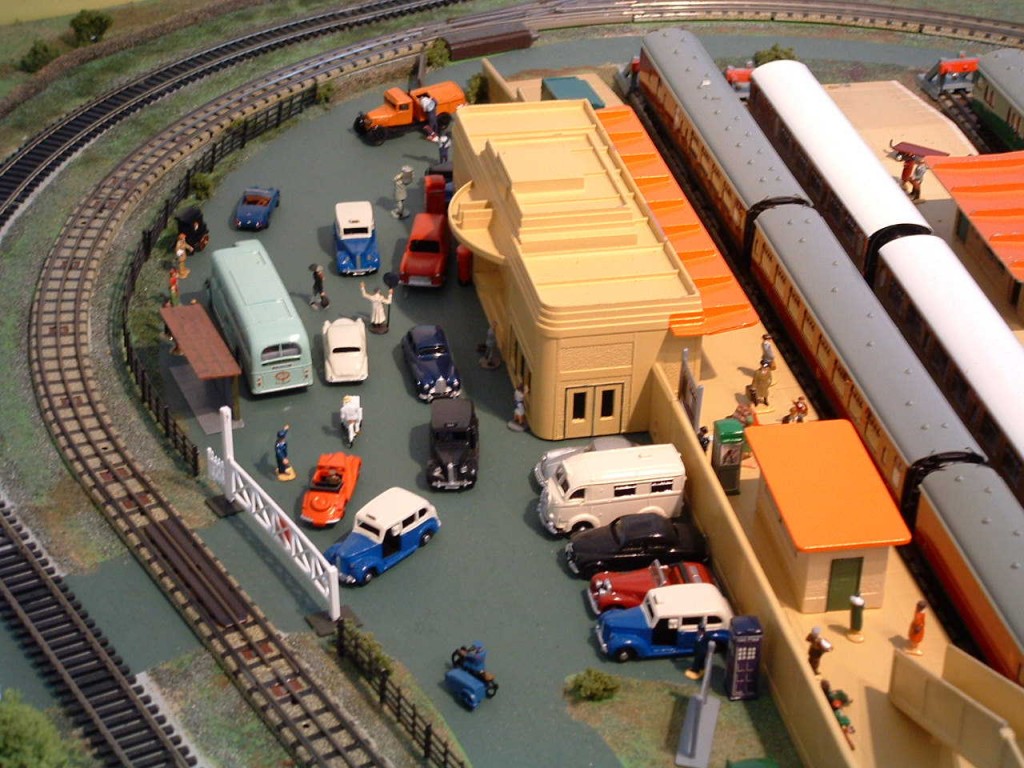 1) ‘New Build’. These are loco’s constructed from very heavily modified or new castings to produce model’s that H-D never actually made. These loco’s are essentially all hand made and are produced in very limited numbers. Some are issued as certified limited editions with specially printed colour boxes making them highly collectable in their own right. Loco’s to look for that fall into this category are Mike Foster’s V2, Peter Hilton’s A-4 ‘Silver Link’, John White’s Schools class, Ian Coburn’s ‘Black 5′ and Bob Wharrier’s class 57xx 0-6-0 tank engines and the class 56xx 0-6-2 tanks that were specially built for this layout and not least Peter Good’s superb models which are now to numerous to mention individually.
1) ‘New Build’. These are loco’s constructed from very heavily modified or new castings to produce model’s that H-D never actually made. These loco’s are essentially all hand made and are produced in very limited numbers. Some are issued as certified limited editions with specially printed colour boxes making them highly collectable in their own right. Loco’s to look for that fall into this category are Mike Foster’s V2, Peter Hilton’s A-4 ‘Silver Link’, John White’s Schools class, Ian Coburn’s ‘Black 5′ and Bob Wharrier’s class 57xx 0-6-0 tank engines and the class 56xx 0-6-2 tanks that were specially built for this layout and not least Peter Good’s superb models which are now to numerous to mention individually.
2) Re-livery. The easiest way of creating a different loco is to give an old one a new coat of paint, although this is not as easy as it sounds. There are a number of talented individuals who offer painting services to members of the HRCA and several are represented on the layout. Donor models are usually bought from local shops, toyfairs, etc (avoid ebay if possible as the quality of models offered is generally poor) to a cost limit of about £50 (the exception being the ‘West Country’ class were you have to pay upto £100). Only loco’s that have been heavily playworn (where the paint is heavily worn or badly chipped) but are mechanically sound are considered for re-painting as they tend to be relatively cheap to buy in the first place. Typical examples of re-paints are; Mick Turner’s ‘Westward Ho’, Tony Winzar’s ‘CaerphillyCastle’, Mortimer models (Cliff Maddock) 0-6-2 tanks and my own fictitious Co-Bo’s.
3) Wrenn. The models from the G.R.Wrenn company were actually made using original H-D moulds, the only exceptions being the three loco classes that Wrenn made themselves which were; The Streamlined Coronation’s, The ‘Royal Scot’ class and the streamlined Battle of Britain/West Country/Merchant navy classes (commonly referred to as ‘Spam cans), all of which were made in the ‘style’ of Hornby-Dublo and examples of all three can be seen on the layout. These models essentially took over where H-D left off as all three were actually being considered and in some cases a mock-up had been prepared by H-D before they ceased production. Since Wrenn production came to an end inn November 1992 a small number of ‘new’ Wrenn loco’s have become available from a variety of sources. Tony Cooper acquired considerable numbers of castings and parts and has assembled a small number of ‘new’ locomotives and these have now been taken over by Mick Turner. The Wrenn company itself was bought by Dapol who originally intended to re-start production but this plan failed to materialize and the company was sold again to group of enthusiasts who have managed to produce a few wagons and one day may produce new locomotives once more. We wish them well…
The Trains
We hope to be able to show at least 20 complete trains running at intervals throughout the day, most of these can be seen in the stations and goods yards. This section describes those that will be on display plus a few others that may be available ‘backstage’. If you can’t see any particular train that you would like to see in action then please ask, it may be ‘resting’ prior to its next turn of duty and its return could well be imminent. Please note that as these loco’s are generally getting on for 50 years old (even the ‘new’ builds use original motors & chassis) we do have to make substitutions or change loco’s from time to time – just like a real railway.
1) The Bournemouth Belle, One of the Southern Regions premier express trains hauled by one of the following un-rebuilt Battle of Britain class loco’s – ‘Fighter Pilot’ or ‘Exeter’. These are Wrenn models in Southern Malachite Green livery and have been professionally converted to run on 3-rail track by using original H-D parts and they represent one of the type of loco’s that H-D could have made using their West Country chassis.
The coaches behind the loco are original H-DSDcoaches repainted by ‘H-D 2000′. Of particular note is the Restaurant car which was produced as a limited edition with only 50 being made. The other coaches are a full brake and a first open (plus a second open or sleeping car if the longer station extension is being used). These coaches were never produced by H-D and H-D 2000 have made them to fill the gaps in the original H-D range.
2) LNER East Coast Express. Either the ‘Silver Link’ or the ‘Bittern’ will head this train. The ‘Silver Link’ is a valanced A-4 loco produced in limited numbers by Peter Hilton in the special silver/grey livery of 1937. The loco uses a new, brass body casting specially produced for this model. Peter however did cast a couple of ‘spare’ bodies and one was acquired and painted by Mick Turner as ‘Bittern’ in LNER Apple Green.
The coaches are all original H-D, re-liveried using Roy Fearn’s Teak effect paper printed sides, look out for the Buffet car and the Full Brake coach to see how realistic these paper sides actually look.
3) The Deltic Preservation Special. An H-D Co-Co diesel re-painted in the colours worn by the class towards the end of their working lives. This loco has been repainted as 55 020 ‘Nimbus’ which was the first of the class to be withdrawn from service. She appears here as she did in her final days in BR service. Another possible loco to be seen hauling this train is the ‘Gordon Highlander’ in early Porterbrook Purple livery. A very colourful combination and a difficult one to re-create but it shows what can be created with a bit of time and effort.
‘Nimbus’ is pulling a rake of three or four BR Blue/Grey liveried Mk.1 coaches, all being re-paints from the skilled team at H-D 2000. The coaches are a selection from; a 1st/2nd Corridor composite, Brake/2nd Corridor composite, Buffet/Restaurant and a full brake repainted as a ‘Newspaper’ van.
4) The YorkshirePullman. Another A-4 class repainted by Mick Turner, this time ‘Merlin’ in early BR Blue. This loco ran in these actual colours for a short time in the early 1950’s and was used to pull this named train out of King Cross hauling some interestingPullmanstock. These coaches are made from original H-D chassis with Wrenn bodies, this give some added variation to the three Pullmans that were made by H-D although simply changing the coupling on pure Wrenn models has the same effect.
5) The Jubilee. This is one of the special models made by Peter Good. Peter has taken an original H-D Castle class loco and has basically cut it into sections and modified, added and then re-built it to make an excellent model of a Jubilee class loco. The coaches behind the loco are Crimson/Cream repainted Mk.1 coaches by H-D 2000
6) The Caledonian, A 2-rail ‘London’ converted to 3-rail and re-named ‘City ofCarlisle’ by Mick Turner. This loco is pulling a rake of Mk.1 Crimson/Cream coaches from H-D 2000.
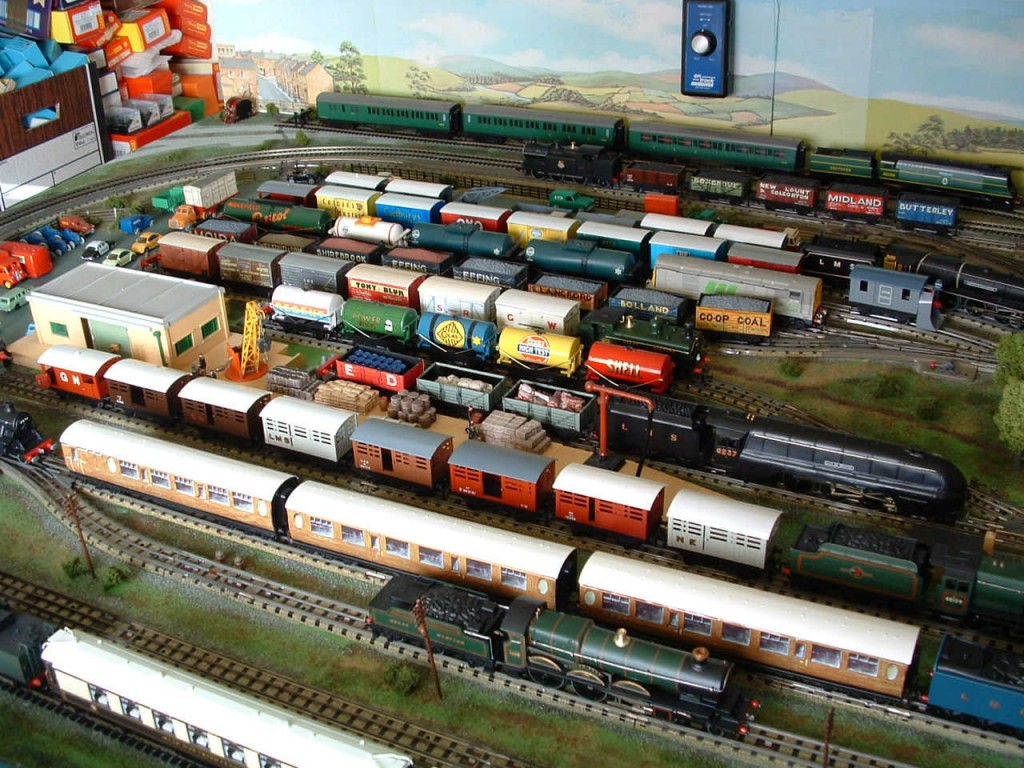 7) The ‘Green Knight’, A Southern Region Loco in later BR colours made by Peter Good. This is one of the ‘specials’ built by Peter in very limited numbers and offered with a choice of names & liveries. It’s seen here hauling a rake of coaches whose identity has been changed by the use of paper overlays.
7) The ‘Green Knight’, A Southern Region Loco in later BR colours made by Peter Good. This is one of the ‘specials’ built by Peter in very limited numbers and offered with a choice of names & liveries. It’s seen here hauling a rake of coaches whose identity has been changed by the use of paper overlays.
8) LMS Express. The ‘Royal Scot’, The W.2260 Wrenn loco of that name in LMS Crimson, again professionally 3-railed, pulling a rake of original Wrenn Maroon Pullman cars. The loco is one of those considered by H-D but it never reached the drawing stage. However when Wrenn were designing the model they looked at ways of keeping the production costs down. To this end they took a tender from the existing 8F engine and, without any modifications, used it with this loco.
9) A Wrenn ‘Lyme Regis’ pulling a rake of Wrenn Southern Pullman coaches
10) London Transport, a repainted 0-6-2 tank in the colours of London Transport from Mortimer Models. This loco will be pulling a pair of original H-D SD Suburban coaches.
11) ‘Eton’ – A Southern ‘Schools’ class4-4-0loco in Olive Green. This is a reproduction of the ‘O’ gauge original and has been built by John White and is one of only six that was produced. The loco is pulling three coaches that have been changed into Southern stock by the use of paper overlays.
12) GWR local passenger; a class 56xx loco in GWR green. This loco was specially commissioned and built for this layout and has been painted by Tony Winzar. It is pulling a pair of suburban coaches that have been re-painted in GWR livery by H-D 2000
13) ‘BreaconCastle’. W.2221B, another converted Wrenn loco in BR Experimental light green. This loco caused some headaches when it was converted to 3-rail. On the original H-D 3-rail ‘Castle’ class loco’s the electrical pick-ups are fitted through holes in the tender, despite having a set of original pick-ups the holes on this loco were too narrow and the H-D units would not fit. A compromise was achieved by the use of a Marklin pick-up which had to be mounted on a block below the tender, hence it is one of only two Wrenn ‘Castles’ in the collection.
The coaches behind the loco are a mixture of original H-D and repaints by H-D 2000, the latter being the full brake and the sleeping car.
Hornby-Dublo Coaches
Whilst there are many variations in original H-D coaching stock it is possible to categorise them into three distinct types.
1) The first coaches were made with solid sides, these had no cut out’s or openings for the windows. Windows were simply ‘printed’ onto the sides although the quality of the printing and especially the shading made them look quite realistic. The only examples of these on the layout are some of the ‘Teak’ sided coaches being pulled by ‘Silver Link’ or ‘Bittern’.
2) The second series had the windows stamped out and a strip of clear plastic inserted so that it was possible to look into the coaches. These early versions had no internal fittings and looked quite bare although it is possible for the enthusiast to build and fit their own interiors. The later versions had the corridor partitions installed and the series culminated in the superb ‘D.20′ Restaurant cars which had full internal detail. There are none of these coaches shown on the display as they were eventually superseded and replaced by;-
3) The final and finest coaches are quite rightly called ‘Super-Detailed’. These were introduced in the late 1950’s and whilst retaining the superbly printed sides they now sported detailed moulded plastic ends and roof’s together with full interior detail. However it is the quality of the printing and the detail that is included which make them the finest model coaches ever produced. There are only one or two of these on the display, look for them on the GW passenger trains and try and spot the difference with the H-D 2000 re-painted coaches. Towards the end H-D did introduce a few coaches with plastic bodies, these being the threePullmancars. These still are superb models and when the company was sold to Wrenn these were the first (and subsequently only) coaches ever put into production by Wrenn
Reproduction Coaches
There is currently only one commercial source of reproduction coaches, Mel Cammish and his colleagues who re-paint original H-D Super detailed coaches under the H-D 2000 banner. These coaches are produced in a range of liveries that H-D never managed to make (Mel say’s that he can produce almost 100 different variations). Mel can even tailor make coaches (to a limited extent) with special paintwork or coach numbering which enables long rakes of differently numbered coaches to be built up. It is even possible to build up actual formations by using this service.
Taking a different approach is Roy Fearns who trades under the name of Renaissance Models.Royis an artist and has produced a series of paper overlays to be stuck to the sides of old and playworn coaches.Roymakes a vast range of these overlays several of which can be seen on the layout. There are also several other HRCA members who also produce or re-paint coaches but these members only occasionally attend or have stalls at specialist toy fairs and their products are not generally available.
Wrenn Coaches
Wrenn originally planned to produce all the coaches that were made by H-D in the liveries that H-D did not get around to producing, unfortunately neither did Wrenn. The only coaches that Wrenn ever made were the threePullmancars, these were however made in a wide variety of finishes, names and numbers. The most common are the replica’s of the original H-D coaches, the Umber/Cream cars although the range of names and numbers of the individual cars was greatly increased. There were also dedicated ‘Golden Arrow’ cars produced with the distinctive ‘GA’ flashes. Wrenn also introduced all Green Southern and all Red LMS versions as well as the BR Blue/Grey livery, including a series of cars for the ‘Brighton Belle’. In total Wrenn made some 37 (known) variations of thePullmancoach from the three H-D originals.
Freight Trains
1F) A 2-8-0 class 8F heavy freight loco, re-painted by Mick Turner in BR lined Green. This was the first ‘non-standard’ loco that I acquired and although this type of loco never carried this livery in real life the colour scheme really suits it. The loco is pulling a rake of upto 10 Private Owner vans all produced by John White. These are all small scale copies of original ‘O’ gauge models and are made by using specially printed paper overlays stuck onto an original H-D truck. The brake van at the rear is a specially made truck from Brian Huxley.
2F) Great Western Freight; This train is hauled by a GWR class 47xx fright loco which was converted from an original 8F by Peter Good who also had to build a totally new tender. The trucks behind the loco are all reproductions and are a mixture of vehicles from the hands of Brian Huxley and John White. Of particular note are the Bogie vans, these were planned by John as part of a range of limited editions but they never entered production and only about 15 were actually made, these being some of the prototypes.
3F) A ‘Freightliner’ Co-Bo (class 28). A very hypothetical livery as these loco’s never actually survived beyond the 1970’s, indeed only one of the class had a livery change and that was into BR Blue. The loco is pulling a rake of 4 container flat wagons in a variety of liveries. Each of these trucks is hand made although the containers are current production Bachmann.
4F) Another Co-Bo this time re-painted in 1990s English, Welsh and Scottish colours, this being another of my re-painting efforts. The loco is pulling a rake of five or six of John White’s superb bogie tankers. John produced and offered a series of these covering 21 livery variations, the total production run being limited to 125 trucks. An alternative loco sometimes used on this train is another Co-Bo, this time in recent ‘Mainline’ blue colours, again another hypothetical livery.
5F) ‘Coal Working’, another of peter Goods superb models, in this instance a Bullied class Q1 in BR unlined black. You would never guess that the basis for this loco is a venerable 0-6-2 tank!. The loco is pulling a long rake of Coal and side tipping wagons all made by Brian Huxley.
6F) Great Western light Freight. This is a reproduction loco of a GW class 56XX painted by Tony Winzar and is pulling a rake of reproduction trucks from Brian Huxley. Several of these trucks are quite unique and have been built by Brian specifically for this display. The trucks that are not part of Brian’s standard range are the tall 7-plank open and the 1-plank with the cable drum.
7F) An 0-6-2 tank in LNER unlined black. This loco is one of a series of 250 models covering some 20 livery variations produced by Cliffe Maddock. The loco is pulling a rake of reproduction wagons produced by John White and Brian Huxley. Again note the bogie van, one of the few of the first series made by John White.
8F) The BR Black liveried A-4 class loco ‘Sparrowhawk’, re-painted by Tony Winzar from an original H-D Silver Link loco. The engine is pulling a rake of reproduction wagons all made by Brian Huxley. These include the colourful Barrel wagons which have removable loads and several Cement and salt wagons which Brian makes in a variety of liveries.
9F) An LMS2-6-4tank in lined LMS black and very smart it looks too. The loco was re-painted from an H-D original ‘80054′ by Tony Winzar. This loco is pulling a small rake of appropriately liveried trucks made by Brian Huxley and John White.
10F) An Olive Green Southern 0-6-2 tank this time re-painted by Mick Turner. This loco was found in a highly ‘distressed’ state in a model shop inSheffieldand Mick completed the restoration. The trucks it is pulling are all reproductions from John White and Brian Huxley. Of particular note is the Snowplough at the front of the train. This is one of an edition of 50 made by Brian, look closely and you will see the blades at the front turn as the truck is pushed along.
11F) Southern Express freight; A Urie class H15, yet another loco from the hands of Peter Good reproduction. This is a special ‘one-off’ built by Peter to add a bit of variation to Southern region fright trains. The loco is pulling a rake of Southern trucks made by Brian Huxley and John White.
12F) LMS heavy freight; An original H-D 8F loco repainted by Mick Turner in LMS Crimson. One of these loco’s actually carried this colour scheme for a short period before WW2 and is therefore quite prototypical. The wagons it is pulling are made by John White and Brian Huxley.
13F) Canadian Pacific; An original H-D ‘Atholl’ converted with the aid of parts produced by Bob Wharrier and painted in the appropriate colour by Tony Winzar and finished with John Buxton’s transfers. The loco is pulling a mixture of reproduction bogie trucks and a replica brake van all from John White.
14F) The War Dept Ambulance Train. An original H-D 8F repainted by Tony Winzar in a War Dept light grey. The loco is pulling a small ‘Red Cross’ train that has been specially made by Brian Huxley. The bogie crane truck is one of a limited issue of 25 units made by Brian. The remainder of the trucks/coaches have been made and painted specifically for this train.
15F) The Shildon Bo-Bo, a replica of an Electric loco from the late 1930’s that operated on heavy coal trains in the North of England made by Roy Fearns. The loco was originally intended to be issued as a limited edition of 30 but only 6 were actually completed due to the master mould breaking. The trucks it is pulling are all refurbished using paper overlays and very effective they look too. Loads in the trucks are also replica’s, this time made by Bob Wharrier.
Reproduction Trucks
Several members of the HRCA produce reproduction or further variations of H-D trucks and all are represented on the layout.
Brian Huxley made a wide range of 4-wheel trucks and the odd bogie wagon in a series of limited editions. These trucks are all small replica’s of original Hornby ‘O’ gauge originals and faithfully follow the lines of their larger brothers. Brian even managed to reproduce the opening doors of the larger models and his replica of the working snowplough is a marvel to see in action.
John White made no pretence with his bogie tankers, they are simply enlarged versions of the ‘O’ gauge originals. The tankers are very colourful, as can be seen from the rake on the layout which represents only a small example of the 21 livery variations that John produced. John also made a small range of 4-wheel tankers and a series of 4-wheel private owner vans which are replicas of Hornby ‘O’ gauge originals.
Peter Hilton produced a wide range of rolling stock including reproductions of the early H-D 4-wheel tankers as illustrated here by the ‘Royal Daylight and Power Ethyl’ (with hand symbol) tankers. Peter also produced a few loco’s in very limited numbers, again as seen here by the valanced A-4 ‘Silver Link’ in LNER Silver/Grey livery.
Paul Draycott now produces a range of tin-printed 4-wheel tankers, these are made in very limited numbers but are identical in style to original H-D. Paul also repaints coaches and is planning to issue an early LMS 0-6-0 Diesel shunter.
Wrenn Trucks.
Wrenn made a vast number of trucks using the original H-D tools and moulds and greatly increased the number of variants of each type of truck. Trucks that appeared in the greatest number of variants include the Coal/Open wagon with 22 known variations, The Hopper with 12 known variants and the Ventilated van which has at least 20 variations. These trucks (and Wrenn loco’s and coaches) could all have been made by H-D and we are fortunate that Wrenn saw the potential and continued production of these superb wagons. Wrenn eventually ceased production at the end of 1992 and the tools and moulds were bought by Dapol who subsequently sold them on to what has now become ‘Wrenn, Cheshunt’ who have started to re-issue some of these fine trucks under their own brand name.
Static Displays
1) In the middle of the main layout is the Freight Area. This comprises a goods Depot with four served sidings plus a further four holding sidings beyond. To the front of the Depot is the access line with a passing loop. All these sidings and the loop will hold the freight trains that will be running during the exhibition. The goods depot itself is an original H-D building extended with H-D plastic platform and ramp sections. The loads on the depot awaiting loading are a mixture of original ‘Merit’ items and current models from PECO and Harburn Hobbies range of resin cast loads. The depot personnel are also a mixture of reproduction figures made by Bob Miles and original ‘Merit’ figures. The vehicles around the freight area are mainly reproduction models made by the late Bob Wharrier but also include several of the limited edition lorries made by Canterbury Miniatures and a few modern ‘EFE’ models and also a few recent models made by John Day which fit in very well..
2) The town station area to the right of the layout will hold a number of the passenger and freight trains that will be running during the exhibition. The station itself comprises an original H-D Aluminium main line station set with an extension platform together with anAluminiumIslandstation also with an extension section, these serving three lines. The small buildings on the platforms are a mixture of original 1960’s Tri-ang kiosks and reproductions. The passengers are also a mixture of those made by Bob Miles and original ‘Merit’ figures. The vehicles on the station forecourt and approach road are also mainly reproductions together with a few recent buses and cars from EFE,Oxford& new Hornby Skaledale.
3) To the front of the Town station is a small coal yard served by one siding. The coal staithes are current PECO models whilst the coal office, figures and other small items are original ‘Merit’ pieces from the 1960’s. Vehicles and figures are a mixture of reproduction and currently available items.
4) The Terminal station area is the most impressive element of the layout. In it’s full size form it occupies an area of 4′ x 6′ and has platforms capable of holding 8 full trains plus a small engine shed (for this exhibition the smaller 4′ x 3′ station is being used). The station itself is in three distinct sections. The red/grey main building is a Tri-ang version of the original H-D model and was made in the late 1960’s. The moulds were never altered and still have the H-D logo stamped onto them. The other sections of the station are original H-D and are a mixture Plastic and Aluminium buildings arranged to form two separate station areas.. As displayed here only the upper and central stations are being used for the trains. Look also for the appropriate vehicles and buses around the station buildings and in the approach roads and also for the identifying signs on the platforms. The other buildings in this area are an original Tri-ang signal box and water tower from 1965 with the kiosks, figures and vehicles all as noted for the town station.
5) The engine shed. Ironically this is a French made ‘Playcraft’ model dating from 1966/67 and is basically a copy of the original H-D building albeit with a few subtle detail changes, however it fits in well with the colours of the terminal station. Loco’s ‘on-shed’ will vary but could include;-
The Falcon; Another of Peter Good’s superb models, showing that Peter does not confine his talents to just steam loco’s. This one started life as an H-D Co-Co and has been extensively re-built by Peter.
A ‘Virgin’ liveried Co-Bo, another of my re-paints again using Fox transfers to finish.
City of Bradford, another Peter Good loco, this time as it ran on Southern Region during the exchange trials of 1948.
Blue Star Line, a H-D ‘Barnstaple’ converted to 3-rail and re-painted by Mick Turner.
Royal Mail, an Unrebuilt Merchant Navy class in BR Lined Blue built by Tony Cooper.
‘Stowe’, another of John White’s ‘Schools’ class, this time in BR Lined Black.
E 3001, a replica of the last H-D loco, this one is a tri-ang model converted to 3-Rail.
‘City of Bristol’, a rare Wrenn streamlined ‘Coronation’ class loco but built from bits found at the Dapol factory by Tony Cooper.
Collecting and Running Hornby-Dublo (and ‘Neverwazzass’)
The first piece of advice for anybody wishing to collect or run Hornby-Dublo is to join the HRCA. The services offered by the many members range from the provision of the most basic spare parts to the manufacture of complete locomotive’s and of course an abundance of free advice, information, help and endless enthusiasm.
Despite the last original H-D model being made over forty years ago there are still a large number around. Most good model shops that deal in second-hand models will have a few H-D items of varying quality available. Prices for the rarest and most sought after items will naturally be high, if you are looking for a boxed 3-rail ‘City ofLiverpool’ or a ‘LudlowCastle’ don’t be surprised to see a price tag of over £500 for a model in near mint condition. Common loco’s, such as the ‘Duchess of Montrose’ or the standard 2-6-4 tank (cabside number 80054) can be obtained in a reasonable condition for £35 – £45 (unboxed) and in excellent condition (with a decent original box) for around £125. A-4 loco’s (Mallard) and 8F freight loco’s (48158) cost around £25-£50 more. Re-paints of fair loco’s cost from around £25 (for an 0-6-2 tank) upto around £60 for a fully lined engine and tender (depending on the chosen name & livery). A fully restored/re-painted Duchess can be ‘on the track’ for around £100, not much more than you would have to pay for a modern Hornby or Bachmann loco.
Coaches and rolling stock are also still readily available but as with loco’s rare and highly sought after items command premium prices. Whilst it is possible to get a near mint Super-Detailed BR maroon Composite or Brake/2nd coach for around £25 you will have to find about £200 for a matching Restaurant car. Prices of trucks are generally around the £10 – £20 bracket for ‘run of the mill’ items in very good to excellent condition with an original box but sought after pieces such as the Southern Region Tinplate trucks and the Super Detailed Hoppers or Caustic bogie tankers can cost upwards of £100 per item in excellent condition.
If you intend to run H-D 3-rail then track should be your primary concern. Surprisingly there is still a large quantity of almost mint boxed track available from specialist dealers but for track in this condition the costs are quite high. Expect to pay upto £3 for a ‘long’ straight (about 300mm in length, a box of six can cost £15 – 20). £4 – 5 will buy you a manual point (or turnout to use current terminology) whilst an electrically operated point will cost around £15 (complete with switch). Amazingly the smaller track sections such as the 1/4 or 1/8 straights are comparatively expensive at upto £4 each but these are difficult to find in mint condition as not that many were actually made. 1st Radius curves are cheap and can be found in excellent condition for as little as 50p. It is possible to find track a lot cheaper than this and some dealers have been known to give away circles of 1st radius curves when you buy some other item. But remember – the quality of the track you use will determine how well your trains run, cheapest is not always the best. Before parting with your cash always take a good hard look at the track you are considering buying. Track should be perfectly flat and not deformed in any way, look along straights to see that they are free from ‘kinks’ and undulations and always lay pieces on a flat surface to ensure that they sit properly and do not ‘rock’. The fishplates (rail joiners) should be attached and not be separate or too loose and the electrical contacts at the ends should be horizontal and not bent up or down beyond 30 degrees. Track that is dirty can be cleaned easily with some soap and water by rubbing with a stiff (but not solid) paint brush but before washing any track have a look at the underside. The centre rail insulators were made in two materials, on early track they were made of paper/card which is a light buff in colour, if you get this wet it tends to disintegrate thereby ruining the piece. Later track had mica (a form of plastic) insulator which is a dark red/brown in colour and this tends to be waterproof. DO NOT wash any electrically operated track accessory such as electric points or uncoupling rails .
You should avoid any track that shows signs of rusting and if in doubt – don’t buy. Track is generally readily available and most good model shops will have some, usually thrown into a box at the back of the shop. Examine each piece carefully, discarding those which fail to meet the above criteria. You can find some bargains but a lot of track that is found in such circumstances is generally unsuitable for use.
Swapmeets, Toy fairs and auctions all provide opportunities for adding to your collection. Try to buy from known, reputable dealers, you may have to pay a little more but their reputations rest on what they sell and it is not in their interests to sell fakes or items that don’t work. Look for dealers who sell predominantly what you are looking for – they will tend to be the specialists.
Auctions are a popular way to acquire all manner of items but beware, they are fraught with danger for the unwary. Catalogue descriptions are at best vague and may not list all the imperfections that exist in the lot offered and there is no guarantee that any particular item will actually work. Also major modifications or structural changes may have been made to the model and may not be described. Unless you know what you are looking for it may be extremely difficult to spot such changes without actually taking the model to bits, which you simply cannot do at a viewing. It is not unknown for lots to comprise a large number of items, all of which may not be of the same make, a lot of 40 -50 trucks cannot adequately be described in three or four lines of text. If you intend to buy at auction know exactly what you want and set your limit and don’t exceed it…And don’t forget the ‘Buyers premium & VAT’ which can add up to a further 20% onto the hammer price. If the item/items are not in the condition that you want simply don’t buy – don’t be tempted to settle for ‘second best’ just because it’s there as there is bound to be another lot in another auction within a few months that will give you exactly what you want – I speak from personal experience!!!
Internet Auctions (such as Ebay) are now very popular places to acquire what appears to be “a Bargain” but as with all auctions it’s a case of Caveat Emptor – buyer beware…Items of rolling stock may not have all the imperfections noted and locomotives, unless from a known & reputable source, can require considerable work to make them work. There are also a few unscrupulous sellers who offer fakes in the guise of originals or even pass off repainted loco’s as originals. Even track looks good in pictures but in reality it can be rusty, deformed and all but unusable. Study the pictures very carefully and don’t hesitate to ask questions and after that, if you are left in any doubt just don’t bid.. Saying that there are a couple of decent auction sites, for instance, Peter Davies who runs “Dublo Auctions”, prices are slightly higher but you will get seriously good stuff..
Replica’s and reproductions, as noted on earlier pages several members of the HRCA are actively engaged in the manufacture of reproduction and replica items. These range from complete loco’s, through to various items of rolling stock and down to individual passengers with which to populate your stations. Many of the larger items are produced in very limited numbers and are only available to HRCA members. The individuals and their products are all detailed in the HRCA ‘spares directory’ which is issued to members of the HRCA and is updated every year. Any changes, additions and deletions to the listings are detailed in the monthly HRCA magazine – which is worth the subscription alone.
The HRCA
The HRCA was established, as this exhibition commemorates, forty years ago by a group of individuals who had but one aim; the preservation of the railway products of the Meccano Company. The initial thoughts centred around the original ‘O’ gauge system but this was soon expanded to cover ‘Dublo’ as well. The HRCA now has some 3000 active members worldwide and many of these provide invaluable services in the manufacture and supply of the smallest part to complete items to keep these wonderful models running 50 years plus since manufacture stopped. The annual ‘Spares Directory’ issued free (to members only) lists these talented individuals who provide their services for little or no profit to themselves and whose aim is the continued enjoyment of Hornby trains for generations to come.
Acknowledgments
These are the individuals who have helped me to create the layout displayed, either by re-painting, overhauling and restoring loco’s to the manufacture of new items. Many of their names appear in the main text which also describes their specific fields of expertise.
In alphabetical order;-
John Buxton, Mel Cammish, Paul Draycott, Roy Fearns, Peter Good, Peter Hilton, Brian Huxley, Mick Turner, John White, Tony Winzar
And to those who provide spares, repairs and the bit’s and piece’s to keep the engines running,
Mike Chambers, Tony Cooper, Peter Davies, Bob Field, Bob Miles, Ron Rayner, Bob Scott, Bob Wharrier, Dennis Williams
The Layout Construction
The layout has been designed to be flexible to enable it to fit into a variety of spaces. The main element consists of three number 1.2m x 900mm (4′ x 3′ for those of us who still work in imperial) baseboards constructed along traditional lines in that they are built from 12mm Plywood on a frame of 18 x 44mm (finished size) PSE (Planed sides & edges) timber, all the joint’s being both screwed and glued. Three further boards of the same size are used to form the terminal station area although depending on space available only one or two will be used. A further 600mm wide board can be inserted into the middle of the layout to give a longer running track and extended freight yard sidings. The six main boards are designed to be stored away and fit together ‘face to face’ to form three ‘cassettes’ to allow for easy storage and safe transport. To the bottom boards are bolted strips of 12mm ply, 300mm wide to which are stuck ‘PECO’ backscenes. These plywood strips also have small angle brackets fixed to them which are used to carry the upper board (face down). These are also bolted to the strips with wing nuts to form a rigid ‘cassette’. This allows the boards to be stored easily, keeps the layout clean and give a convenient size to transport, although they are a bit on the heavy side. All that is necessary to erect the layout is to unbolt the sections, remove the face side panels (two or three, depending upon which terminal is being used), lift off the upper boards and the lock them together with carriage clips. Once the removable track sections have been fixed the layout is operational and trains can be running within about 45 minutes (although it takes about two hours to set up all the ‘bit & pieces’).
The main track plan is based on an original H-D design taken from a book of track plans dated 1959, although the number of sidings has been greatly increased. The layout of the Terminal station area was developed to suit the main circuit and to act as storage siding/fiddle yard as well as giving the trains somewhere to go.
Scenic effects are limited to a few trees, hedges and fences and an overall covering of appropriately coloured ‘scatters’ which are simply scattered into wet matt varnish (well before it has dried).
As noted the majority of the vehicles and ‘passengers’ are from Bob Wharrier and Dave Miles respectively but there are a few recent vehicles and buses from EFE, Canterbury Miniatures and J. Day to be seen.
New Neverwassers Additions
To some collectors ‘Neverwass’ are somewhat of an enigma, models that were never made by Hornby-Dublo but which most collectors secretly wish had been. You either love them or hate them but looking at the attached pictures you have to admire the skills and dedication that goes into making them and, like me, give thanks that there are people ‘out there’ who are prepared to make something that extra bit special. My own collection of 3-Rail ‘Neverwass’ is fairly well known and these are some of the latest arrivals, all these being from the very capable hands of Peter Good.
A Urie H15, 4-6-0; Robert Urie’s first design for the LSWR and the forerunner of the more famous ‘King Arthur’ class. The H15’s first took to the rails in 1914 and soon gained a reputation for haulage capacity and reliability, so much so that many were still running in 1961 and could well have been the subject of a Hornby-Dublo model. The loco modelled here represents one of the second batch built in 1924 and is shown in later BR Lined Black guise as number 30477 which she carried until withdrawal in June 1959.
The Jubilee, after waiting for many years for Ian Coburn to produce his long promised (but never materialising) Jubilee I commissioned this one from Peter. It is actually a very heavily re-engineered Castle class loco so, believe it or not, it is all ‘original’ Hornby-Dublo. This particular model is “Silver Jubilee” finished in LMS Crimson
The Bayer-Garrett 2-8-8-2, a massive loco and one of only two to be made by Peter to special commissions. Much effort was spent by Peter to ensure that the loco was capable of negotiating 1st radius curves which it achieves splendidly, even when pulling 30 wagons. Finished in LNER Lined Black this loco is a stunning addition to the fleet.
++++++++++++++++++++++++++++++++++++++++++++++++++++++++++++++++
New Layout
I’m in the (very slow) process of building a large 3-rail layout (very slow as I spend a lot of time out of the UK) to replace my now dismantled ‘Neverwass’ display layout. This will be familiar to members of the HRCA as it appeared at several HRCA shows and featured a couple of times in the pages of ‘The Collector’. The new layout was designed using SCARM but when laid out didn’t actually fit (my baseboard dimensions and set up was ‘spot-on’) so some ‘on-site’ adjustment was necessary. I think that SCARM is not exactly to scale and any errors, however small, are magnified on large layouts, saying that it proved to be invaluable for designing the freight yards and complicated junctions. My layout is partially operational (the inner oval) but has a couple of dozen electric points (with associated isolating rails), uncouplers and signals that still need wiring up
Editor’s Note: I assumed that David was just starting on his layout but he has sent some photos and text of where he is at and they are just amazing. This is going to be a very serious layout.
A General View as of February 2012
The Layout and place names are part in tribute to Frank Hornby & Hornby-Dublo and also reflect my early days around Sheffield, hence we have ‘Newbinns Road’; ‘Frankton’; Dore & Totley; High Moor & Tinsley.
Serious planning work commenced in April 2011 when Garry Hall (member 7957) told me about the SCARM track planning system. This has been mentioned previously so I won’t describe it again other than to say it proved to be a godsend and once I had mastered the system I found it so very easy to use I had several designs on the go at the same time. So, over the next few months I set to and designed the layout to fit the available space finally giving the ‘nod’ to what was design 7B – all I had to do now was build it.
Dore and Totley Station
SCARM has a really useful feature in that it can generate a complete listing of all the track sections required so once all the points, isolating rails, power feeds, etc had been positioned I ran off the list and compared it with my own stock of track. Whilst I had most of the track on the list I was short of 1/8th straights & quarter curves (aren’t we all!) and, more surprisingly, manually operated points of which I needed a further 30! – there are 80 of these on the layout together with about 20 Electric points..
The baseboards were built by the carpenters who were working on the house (one room of which is now ‘home’ to the layout). 100mm x 100mm legs and framed in 150mm x 50mm timbers, topped with 12mm ply and properly levelled they are strong and sturdy and somewhat immovable, god help me if I ever need to take them down!
Dore Village
Track-laying began with the rear main lines as these, being next to the wall (& ultimately hidden from view) dictated the positioning of everything else. Slowly but surely the remaining track pieces were laid – all 700 of them, a few ‘tweaks’ here and there and a few changes and we have the final track plan.
I took the decision at a very early stage to use electric points only in the most inaccessible places around the layout. This was to reduce the amount of wiring (me being lazy) whilst still allowing full operation of the layout from the central well without having to crawl around to change points every time a train ran (me being lazy again!). This reduced the number of electric points I needed to about 20, the majority being in the covered sections of the main Terminal station and the associated loco shed area and goods yards but this has still meant a considerable amount of wiring and, to date, I have used over 300m for the points and associated isolators alone and I still have one section plus the electric signals to install. I have also built in several additional terminal rails which, when used with manual isolating points, allows shunting to take place in the goods yards and main industrial areas while trains are running on the main lines (although it needs 4 twin power controllers with the corresponding pairs of hands & eyes to use them all simultaneously).
The layout design is actually quite simple, there are two operational twin-track ‘lines’; a main circuit which is a basic oval and a separate ‘out & back’ run between Frankton & Newbinns Road. These are linked with some extensive pointwork to give a multitude of different routes between the three station areas.
Frankton Station
I started by placing the primary buildings around the layout, the stations, good depots and the major industrial features I wanted to include. These are the ‘keystones’ of the layout, everything else would have to fit in around them. I have tried to incorporate as many original HD buildings as possible so we have a large (8 over-roof – which I’m looking to extend further) Terminal Station (the later Tri-ang/Hornby Red/Grey version) a couple of cast through stations, a turntable, two goods yards and a four-road engine shed and numerous signal boxes and line side huts. Other buildings and structures come from a miscellany of suppliers, we have kits by Vollmer, Kibri, Faller Pola and Walthers (OK, they are to HO scale but the are just right for what I wanted to achieve), quite a few modern Hornby ‘Skaledale’ and Bachmann ‘Scenecraft’ buildings together with some original Tri-ang and Jouef models from the 1960’s and not forgetting a fair number of Derek Smiths ‘neverwass’ buildings plus some ‘Metcalf’ card kits (including an impressive bus station) and a few hand-built models acquired off ebay. Once the main structures were in position I added the remaining buildings, walls, fences, trees etc although there is still a considerable amount of work to do to finish it off.
High Moor Colliery and Siding
Newbinns Road Freight and Loco Depots
Refinery and Works Corner back in February
The layout is in it’s early stages, the track has been laid and is currently being tested (although having been stored for a few years it needs a good clean) but Co-Bo D5701(in BR Blue) and a 2-6-4 tank have been happily running around finding the ‘weak’ spots and also where I have gauged the tolerances a little to finely – we have demolished a couple of walls and the odd tree! but the major structures all seem to be in the right places and have escaped from being hit. The next big job is the wiring which I have just started but hope to have this complete by the end of February at which point I will start the on scenery proper with all the cameos which will bring the layout to life..
The pictures show where we are at present (November 2012) – I guess it will take another 12 months (at least) to get the layout finished (is a layout ever really finished?) but you can see what has been done so far and it gives a foretaste of what it’s likely to look like when complete.
Building the Layout 2 – The Scenery
The intent was to create a fully scenic 3-rail layout, to show what can be achieved even with a 60 year old model railway system using quite a few original HD and other buildings of the period. The starting point however had to be the ‘back’ of the layout where I planned to create a rock face & quarry so I started by positioning the hillside (which also serves to hide the two back running tracks) to form the working face of the quarry. I cheated a bit here by having a rock face made for me by a chap called .xxxxxxxxxxx. I became aware of this supplier when I bought a couple of tunnel portals from him off ebay. They were so good I asked if he could create a ‘rock face’ for the quarry which he did and the effect is simply stunning. I added a few trees to lift the height so that the rear tracks are virtually invisible.
Totley Sidings and Gas Works

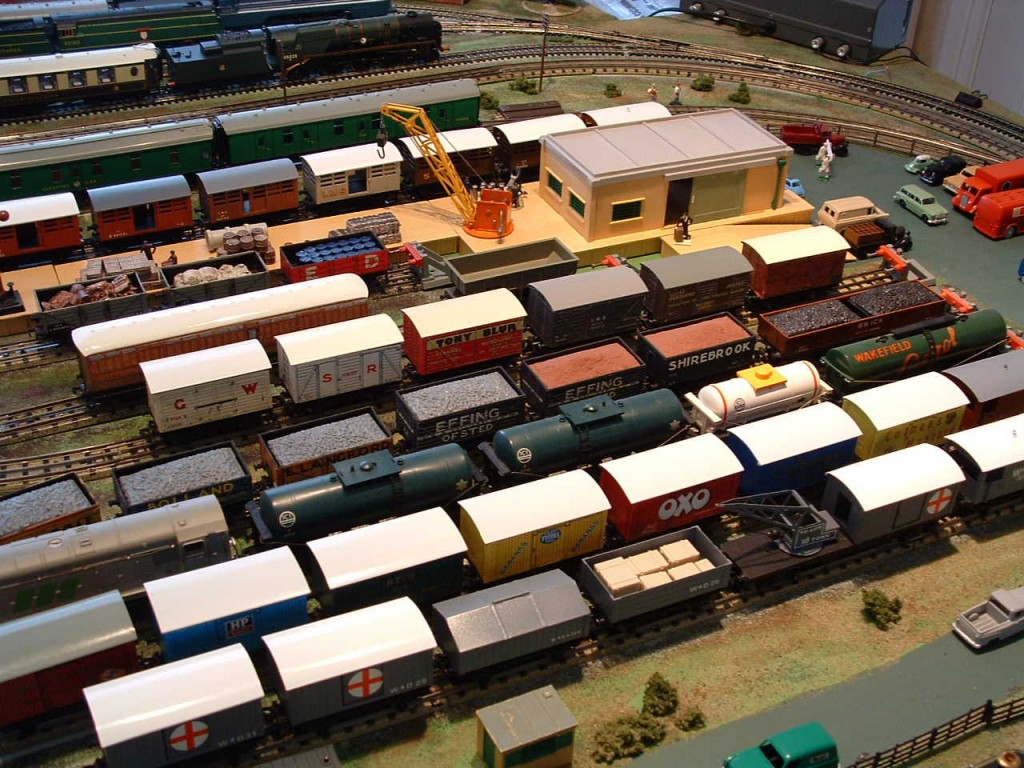
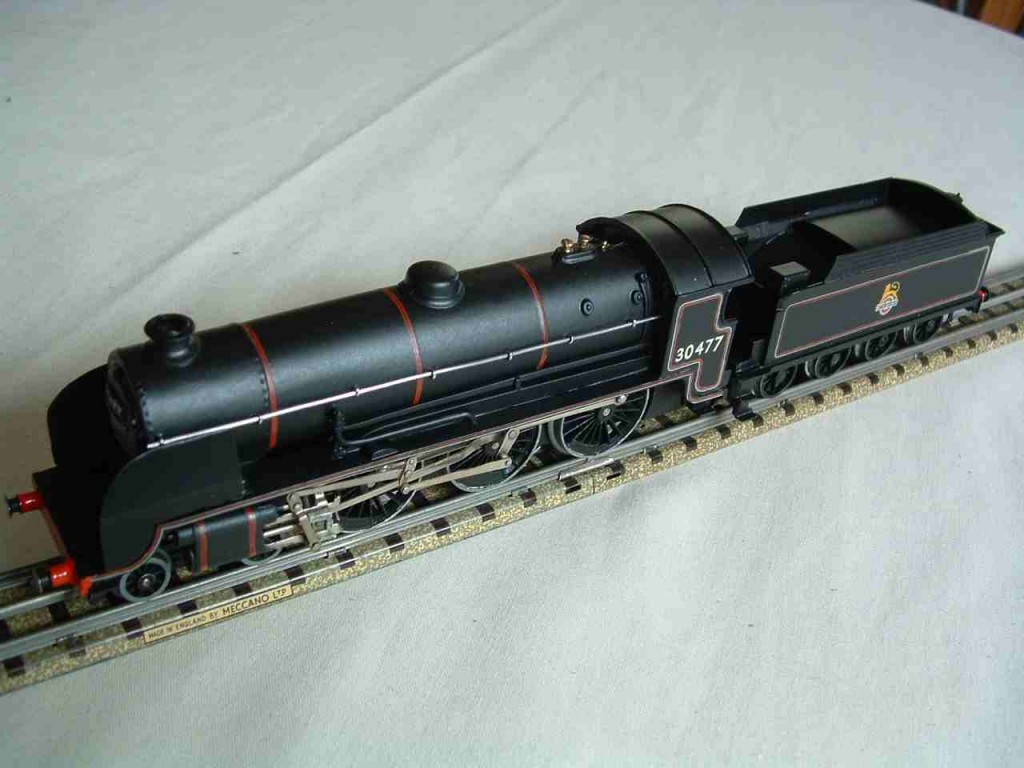
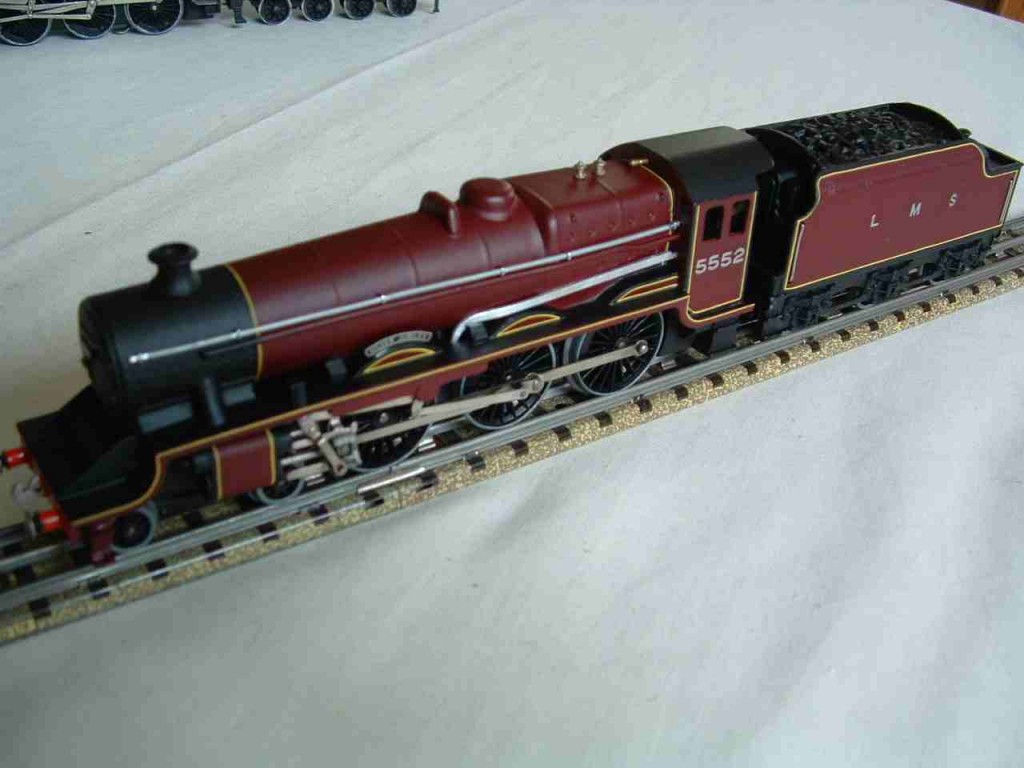
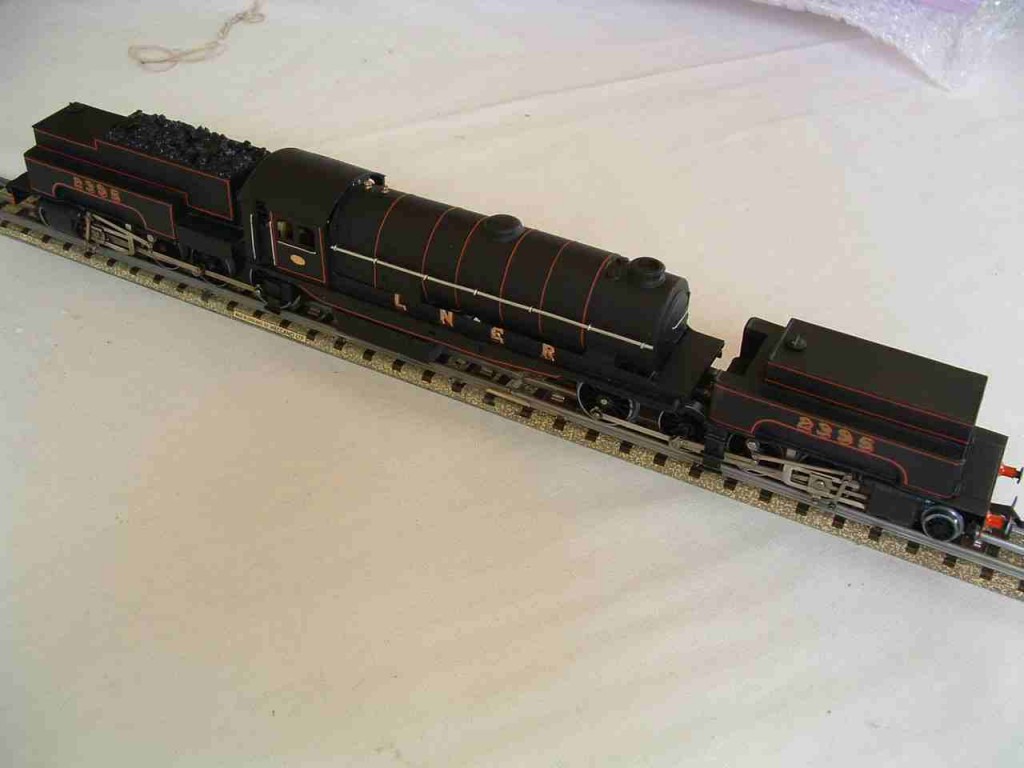
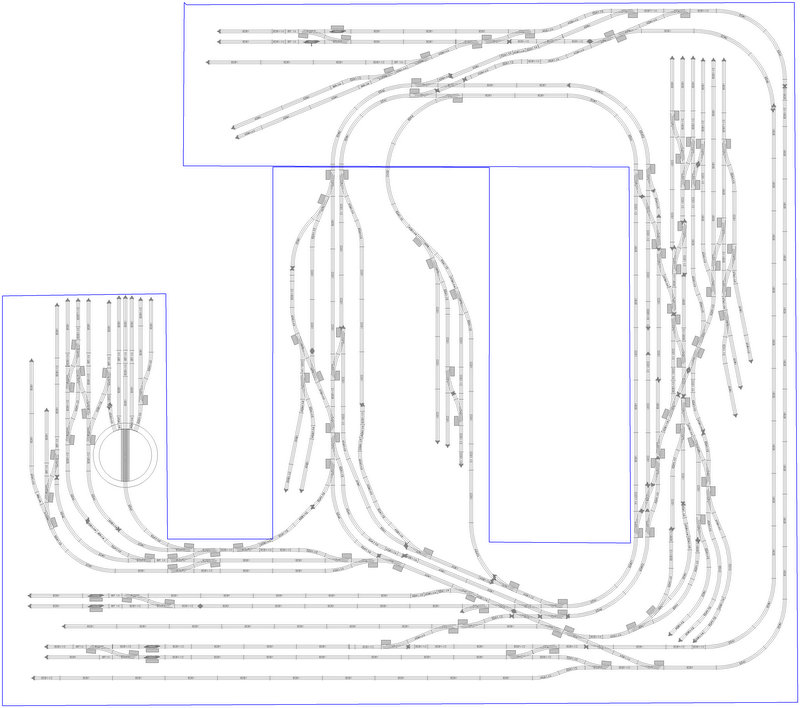
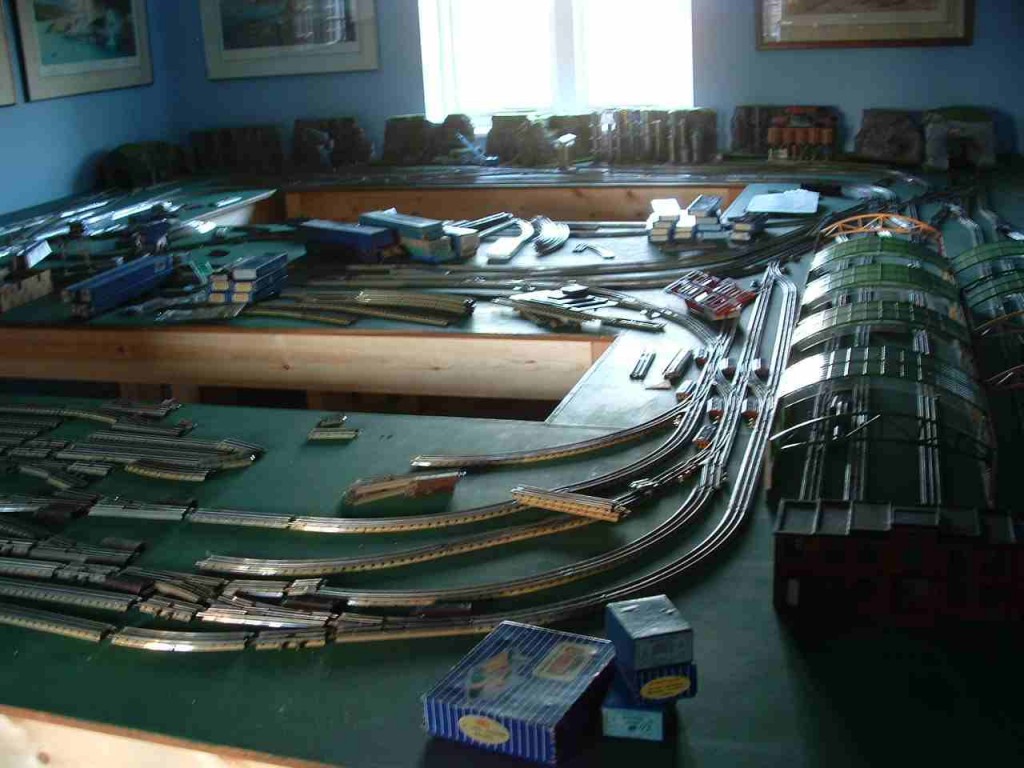
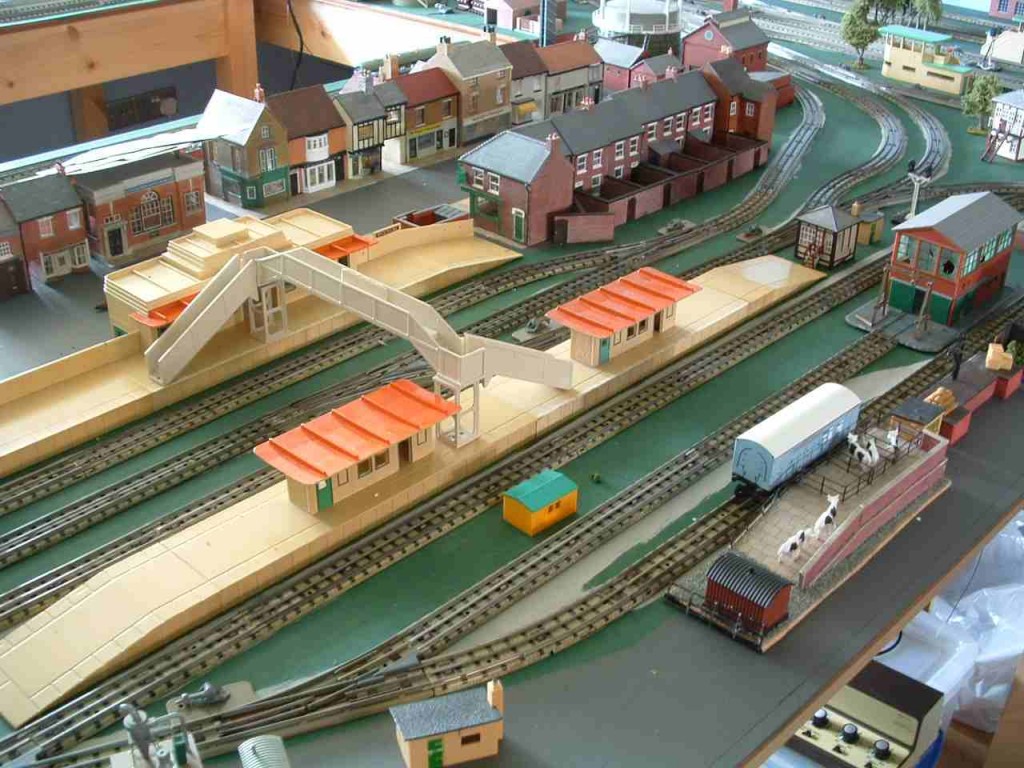
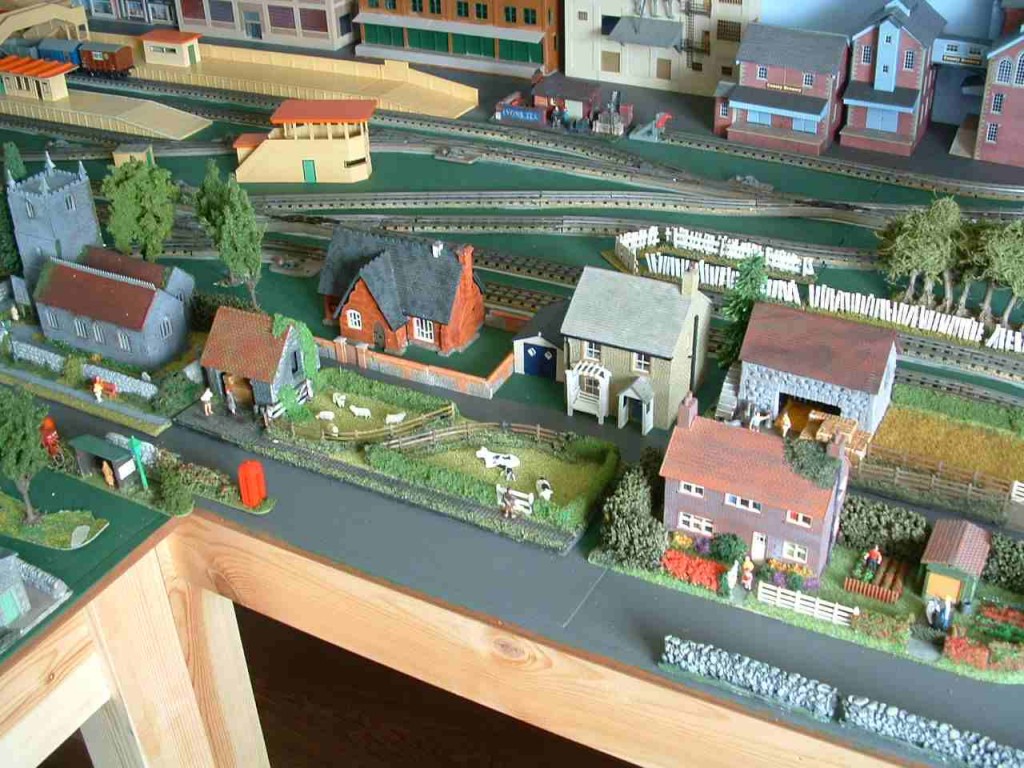
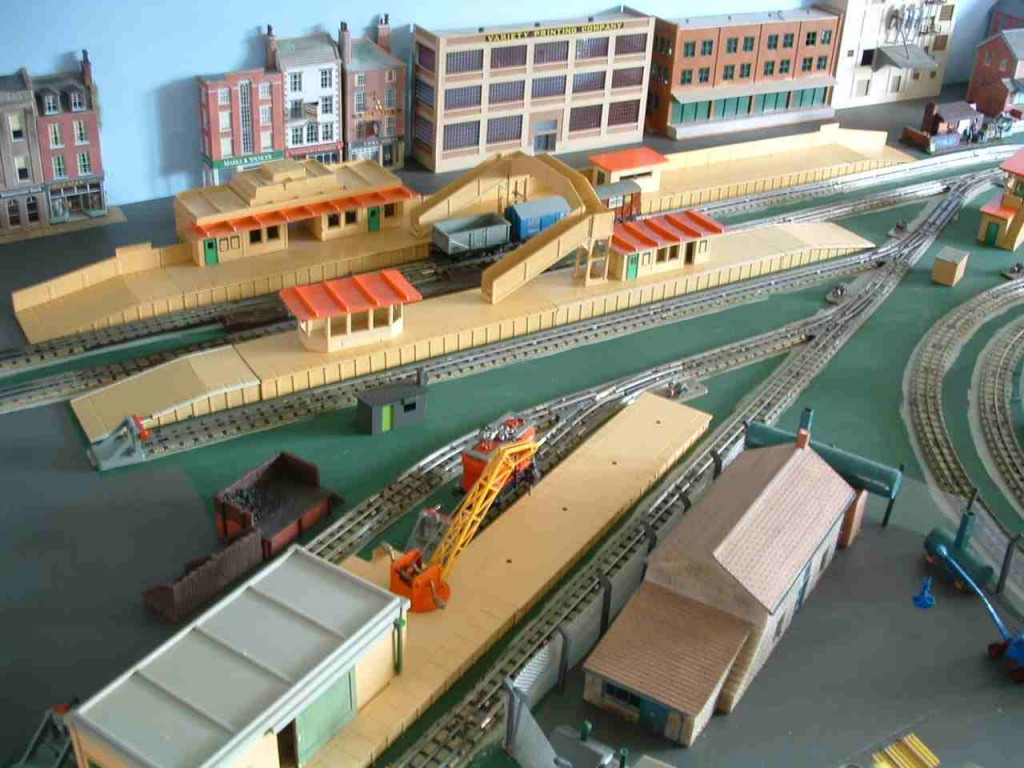
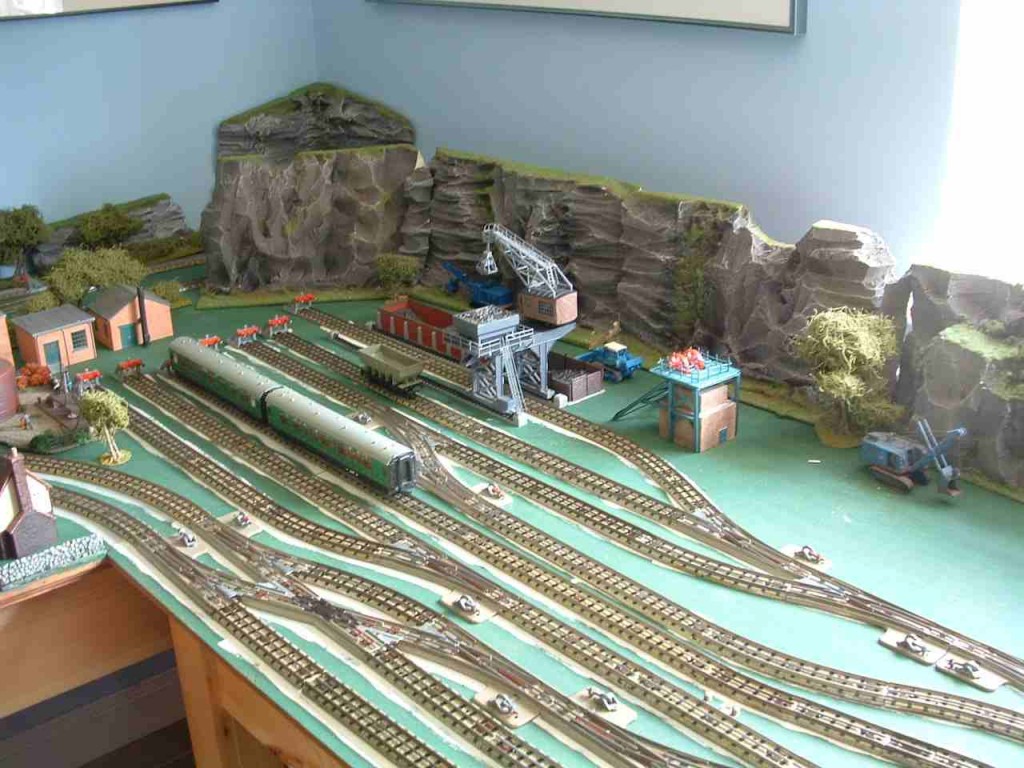
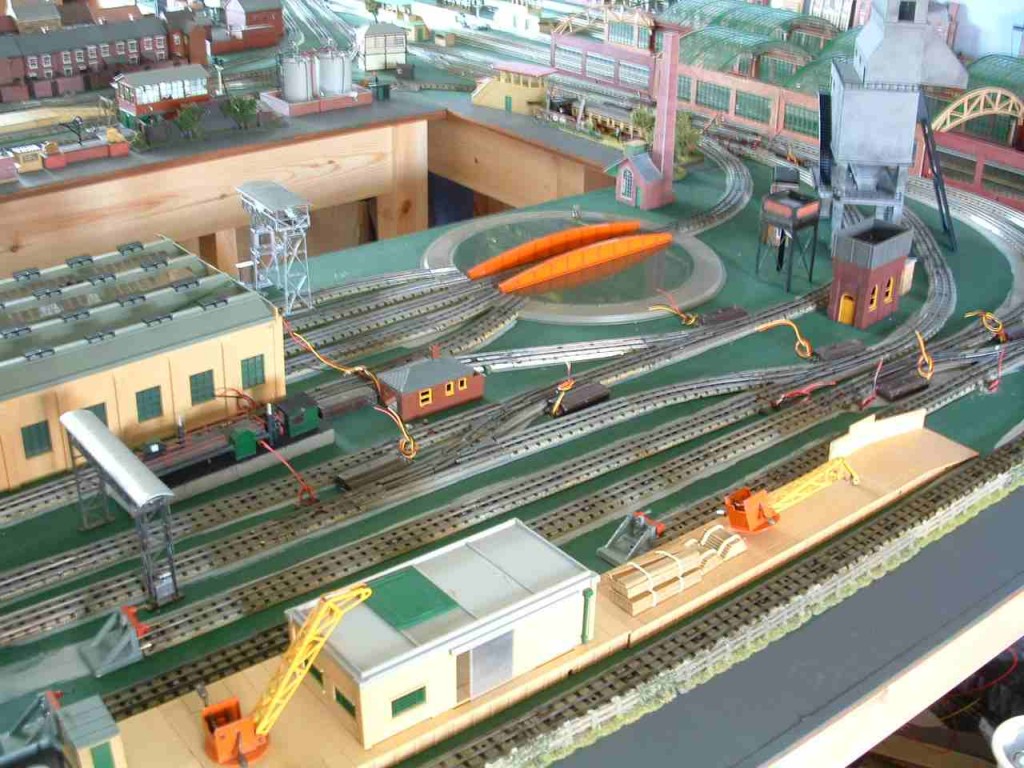
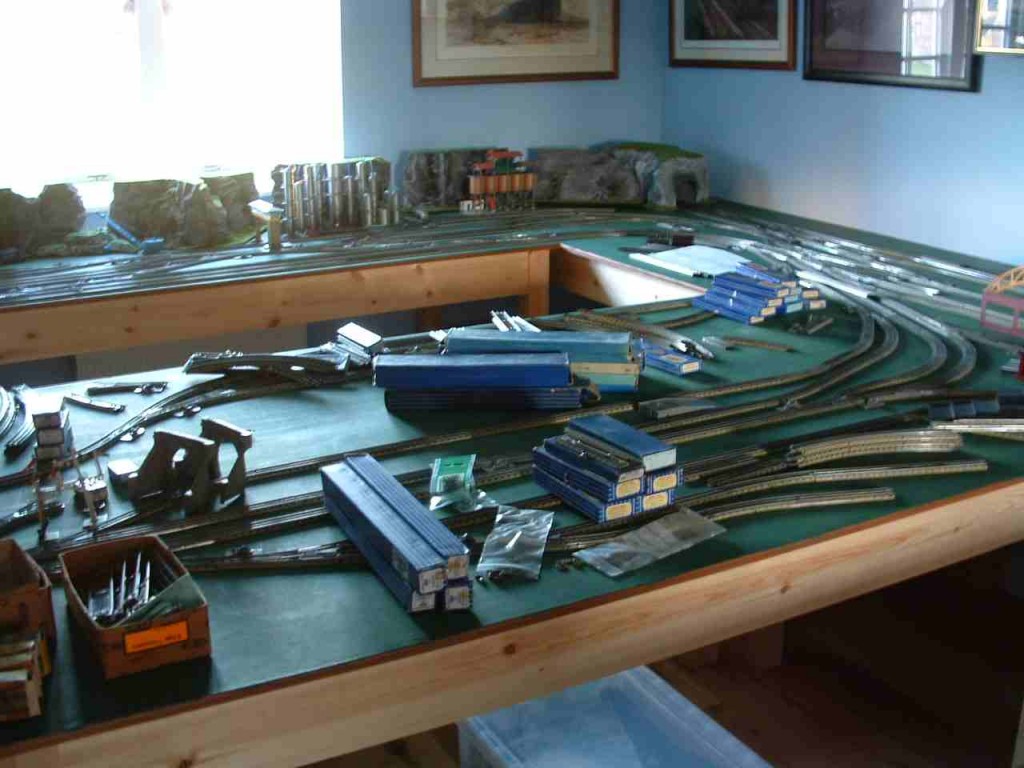
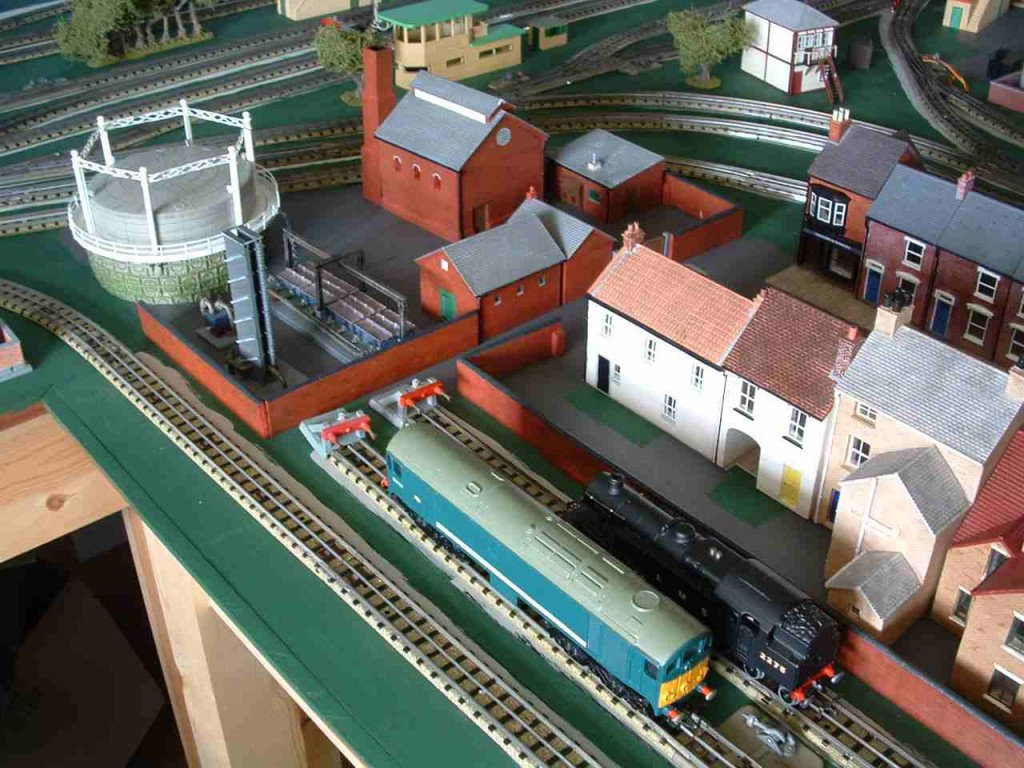
This is most impressive as it is now. It was only around the summer of 2011 that my partner and I went to visit David and his family and the “Railway room” was not built (or finished then) so it is remarkable how it has grown. At that time everything was stored away waiting for moment when railway building could commence. David told me about the size of the layout and sort of things he wanted to include but it was hard to imagine how it would all fit in but this shows how it does. I have seen some of his stock and that again is most impressive. I am looking forward to my next visit to his place and seeing it in operation.
Garry Hall
Hi I am new building and need some help with the D.C.C track I’m building in my shed I have a bridge by the door where I go in and out of the shed the bridge has to be able to be removed some how, ? do you know of any rail connectors so that the bridge can be lifted and replaced easerly so there is a good connection I am open to any suggestion off any way of doing this.
Thanks Eddie
Hello Dublorunner, Just wondered if you could kindly help me locate 2 of your fellow
members. 1 mick turner and 2 tony winzar. I would be most grateful if you would kindly
e-mail me their respective contact details ie e-mail addresses/ telephone numbers. As
I need to source some vital transfers and parts for my restoration projects.
Any help will be grealty appreciated. Thankg you, yours faithfully, reidy321.
I have sent a contact for Mick Turner but I am unable to find the latest contact for Tony. Can anyone help?